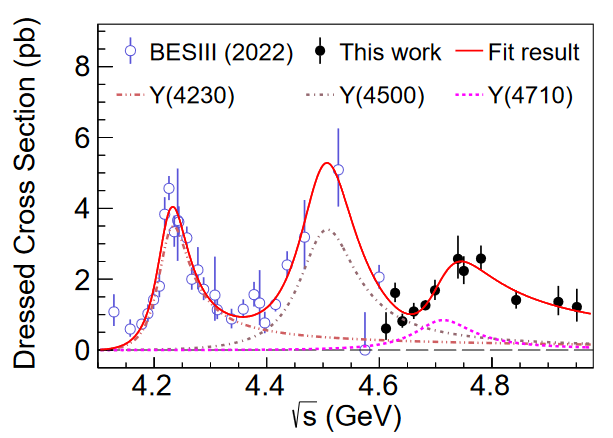In the November 21, 2023 issue of Physical Review Letters, the BESIII Collaboration reported the discovery of a vector charmoniumlike state, dubbed the Y(4710), in e+e-→K+K-J/ψ process. The Y(4710) is observed to decay toK+K-J/ψ with a mass of 4.708GeV/c2. Meanwhile, the search for exotic tetraquark states, dubbed Zcs, are also conducted in this process.
The charmonium system is an ideal place to study the strong interactions of quarks and gluons at the hadronic scale. Below open-charm threshold, many of observed states have been found within expectations under the conventional potential models, and excellent agreement has been achieved between theories and experiments. Above open-charm threshold, however, outlier states which do not match the predictions of the potential models are observed and widely considered to be good candidates for exotic states. To study these exotic hadrons, the BESIII experiment, operating in the τ-charm energy region, has collected the world's largest electron-positron annihilation data sample at 4 - 4.6 GeV and has achieved fruitful and significant results. To deepen our understanding of these states, the experimental data beyond 4.6 GeV is of great interest, which is relatively scarce. The available data above 4.7 GeV are even more limited. Despite technical challenges faced with BEPCII accelerator and BESIII detector, BESIII has successfully collected 3.9fb-1 data samples at 4.6 - 4.7 GeV in 2020, and increased the scanning energy to 4.95 GeV in 2021 to study the exotic hadrons with higher mass.
Based on the aforementioned e+e- annihilation data with an integrated luminosity of 5.85fb-1 collected at center-of-mass energies from 4.61 to 4.95 GeV, the interesting vector charmoniumlike states Y, which are usually observed in hidden charm final state, are studied via e+e- annihilation. In the published letter, the production cross sections of e+e-→K+K-J/ψ are measured with a unprecedented precision. A new resonance structure Y(4710) is observed for the first time in the cross section line shape around 4.7 GeV, with a statistical significance larger than 5 standard deviations. The mass and width of the resonance are measured to be (4708+17-15±21) MeV/c2 and (126+27-23±30) MeV, respectively, where the first uncertainties are statistical and the second systematic. The Y(4710) is the heaviest charmoniumlike state ever observed in hidden charm sector, offering new insights into the charmonium(like) states above the open-charm threshold.

Figure 1 The measured cross section for e+e-→K+K-J/ψ and the fit result.
In addition, a search for Zcs states, intrigued by the recent observations of Zcs(3985) by BESIII and Zcs(4000) by LHCb, are also performed within the KJ/ψ system. While no significant structure is observed, a small excess with a statistical significance of 2.3 standard deviations is seen around 4.05 GeV in the K±J/ψ mass distribution. Meanwhile, the ratio of the coupling strength of the Zcs(3985) with the hidden charm (KJ/ψ) to the open charm (D0barDs* + D*0barDs) is measured to be less than 0.03 at 90% confidence level. These measurements provide valuable inputs for a deeper understanding of the nature of the Zcs states.
Figure 2 The invariant mass distribution of Mmax(K±J/ψ).



